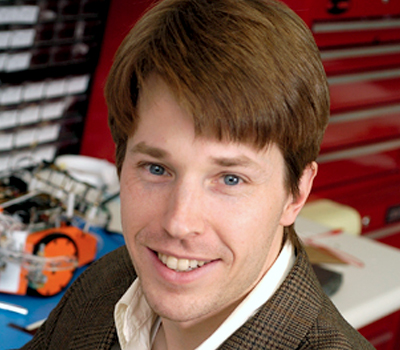Drawing inspiration and understanding from animal movement and translating this into fluid movement in robotics
Animals are proven masters of dexterous movement. Despite the ease with which they control their actions, engineers are currently unable to recreate the same fluid animal movements in robots. Dr. Noah Cowan, Associate Professor of Mechanical Engineering at Johns Hopkins University, draws on his juggling skills and his interest in how animals maneuver through space to understand neuromechanics, the basic neural and mechanical fundamentals of movement. He studies a diversity of animal species— from insects to humans—to better understand a wide range of sensory systems, body dynamics, and neural control systems. By understanding the general principles of movement and control in multiple species, Dr. Cowan’s innovative research yields profound insight that transcends any single organism. His advanced neuromechanical systems can be applied to novel engineering designs and open the door to new technology that will largely improve life.
By designing new engineering approaches for gathering data on natural motor control systems, Dr. Cowan applies biological discovery to confer robust, stable movement to robotic systems. He trains his students in both robotics and biology, enabling them to readily translate their biological discoveries to robotic systems. Their work results in robotically engineered systems with some of the same incredible mobility enjoyed by animals. Robots that move and interact with the world as well as animals will revolutionize a variety of fields, including agriculture, elderly care, disaster recovery, and entertainment. Beyond robotics, studying how movement emerges from a conversation between the brain and body offers promising potential for understanding and treating human motor diseases. Gaining insight into movement fundamentals will—once translated to robotics—revolutionize the way we live our lives.
Current projects include:
- Explore Human Rhythmic Movements - Every day, the average American takes thousands of walking steps, which is underlain by “active neural control.” This is essential for moving in a stable manner on irregular ground, turning to enter a doorway, weaving around traffic, and starting and stopping. Such behaviors—which are natural in healthy adults—are compromised with age or neurological impairment. In older populations, falling is the most common medical problem and a leading cause of fatality. Walking and other rhythmic movements require coordination between the brain and musculoskeletal system that relies on interpreting visual and timing information from the body and surrounding environment. Understanding how the brain controls rhythmic movements has been hindered by mechanical complexity and limitations of currently available analytical and experimental tools. Dr. Cowan's lab addresses these gaps by studying a rhythmic virtual reality task in which humans bounce a ball on a paddle. This task is dynamically similar to walking and likely engages the same neural circuitry. However, it allows precise control of sensory cues and physics that would be fundamentally unsafe or impossible in walking. The objectives are (1) to measure, assess, and model sensorimotor processing capabilities using "system functions," (2) to study how task dynamics and feedback can be used to modulate spatial and timing-based control, and (3) to study how sensory estimation and motor control interact when humans are developing rhythmic movement patterns for new situations.
- Understanding Active Sensing - Animals, including humans, routinely use movement to sense the world around them. For example, to sense the texture of an object, a person might move her hand over the surface, whereas to measure the object's weight, she might hold it in her palm and move it up and down. This use of different movements to sense features of the environment is called Active Sensing. Although active sensing is commonplace in human behavior, how the brain generates and controls these movements is poorly understood. Dr. Cowan and his team want to reveal and describe (in mathematical equations) the brain's strategies for active sensing. This is achieved by studying a specialized animal species, the weakly electric glass knifefish. This animal has a suite of properties that make it ideally suited for the experimental approach. The expected findings will have broad implications for active sensing in other animals (including humans) because active sensing behaviors are similar across species. This will have broad societal impacts, including the possible transformation of robotic control systems and enhanced understanding of the brain that may ultimately improve our understanding of neurological disorders. Further, this work includes multidisciplinary training of promising students in critical STEM fields.
- Closing the Loop Around the Cognitive Map - Dr. Cowan's laboratory, in collaboration with neuroscientists at Johns Hopkins University, has developed a new experimental system that will allow us to gain significant new insights into the hippocampus, a critical brain region that is involved in forming long-term, episodic memories: the vivid memories one has about past events. This area of the brain maintains an internal representation of your position as you move around in your environment, and a Nobel Prize was awarded in 2015 for the discovery of this "cognitive map." One of the great mysteries has been how we integrate our perception of 'landmarks' in our environment with our own internal representation that is updated as we take a step. As we move through the world, we perform subconscious step counting called “path integration” that helps us keep track of where we are in space. In robotics, this is referred to as “dead reckoning”. But this internal representation must be corrected by external sensory information such as the visual perception of familiar objects in our surroundings. How do we reconcile visual landmarks with path integration? Dr. Cowan's new virtual reality system addresses this long-standing question by measuring, in real time, the brain's activity, and using this to control the movement of virtual objects in the surroundings, effectively causing the brain to be immersed in the Matrix. This ability to interpret the brain's cognitive signals in real time, and modify the virtual world accordingly represents a transformative paradigm for understanding cognition and intelligent behavior.
Bio
Dr. Noah Cowan is a talented juggler, and his scientific interest in movement began as a boy while he was learning this skill. While in seventh grade, Dr. Cowan was learning to flip a common household hammer when he discovered that three ways of flipping a hammer produced completely different outcomes. If you flip it from a starting position where the face and claw are vertical, as if to strike a nail, it will spin nicely and be easily catchable. If you take the same hammer and spin it about its handle, it will twist nicely around its handle. In each of those two cases, the hammer continues to twist around the original axis of rotation. But to Cowan's frustration, if you orient the claw and face of the hammer sideways before you flip it, then as it flips the hammer performs an extra, unwanted twist in the air about its handle. As a result you often catch the hammer with the face and claw facing towards the opposite direction from its original, starting position! It might twist left. It might twist right. But, you cannot avoid the extra twist. As a juggler, this baffled Cowan because the ending position, and whether the hammer twists to the left or to the right, depends on undetectable differences in the exact starting position of the face and claw. He realized that this principle generalizes to other objects, and he learned to predict which of the three axes would be the funny one.
Dr. Cowan's obsession with understanding how things moved led him to perform his Ph.D. under the guidance of a visionary roboticist who had developed the world's best juggling robot (it could juggle two balls). Ultimately, Dr. Cowan learned the mathematics to explain why a hammer flips the way it does, but he also arrived at the painful realization that reproducing human skills in an engineered system, such as juggling, was extremely difficult, even though humans can learn such skills fairly easily. To this day, even though a computer can beat the world's greatest chess player, a three year old can move the pieces more effectively.
This paucity in our understanding of how the nervous system subconsciously controls the mechanics of movement has been a driving motivation behind Dr. Cowan's research. He has become a "frustrated roboticist," pursuing the discovery of the control principles that allow animals to move so gracefully and seemingly effortlessly and translating them to enable robotic systems to perform tasks that are - as yet - impossible in robotics.
Noah J. Cowan received a B.S. degree from the Ohio State University, Columbus, in 1995, and M.S. and Ph.D. degrees from the University of Michigan, Ann Arbor, in 1997 and 2001 all in electrical engineering. Following his Ph.D., he was a Postdoctoral Fellow in Integrative Biology at the University of California, Berkeley for two years. In 2003, he joined the mechanical engineering department at Johns Hopkins University, in Baltimore where he is now an Associate Professor. Professor Cowan's research interests include mechanics and multisensory control in animals and machines. Professor Cowan received the NSF Presidential Early Career Award in Science and Engineering award in 2010, the James S. McDonnell Foundation Scholar Award in Complex Systems in 2012, and the William H. Huggins Award for excellence in teaching in 2004.
In the News
The Baltimore Sun
Johns Hopkins Whiting School of Engineering
Science Daily
John Hopkins Whiting School of Engineering


